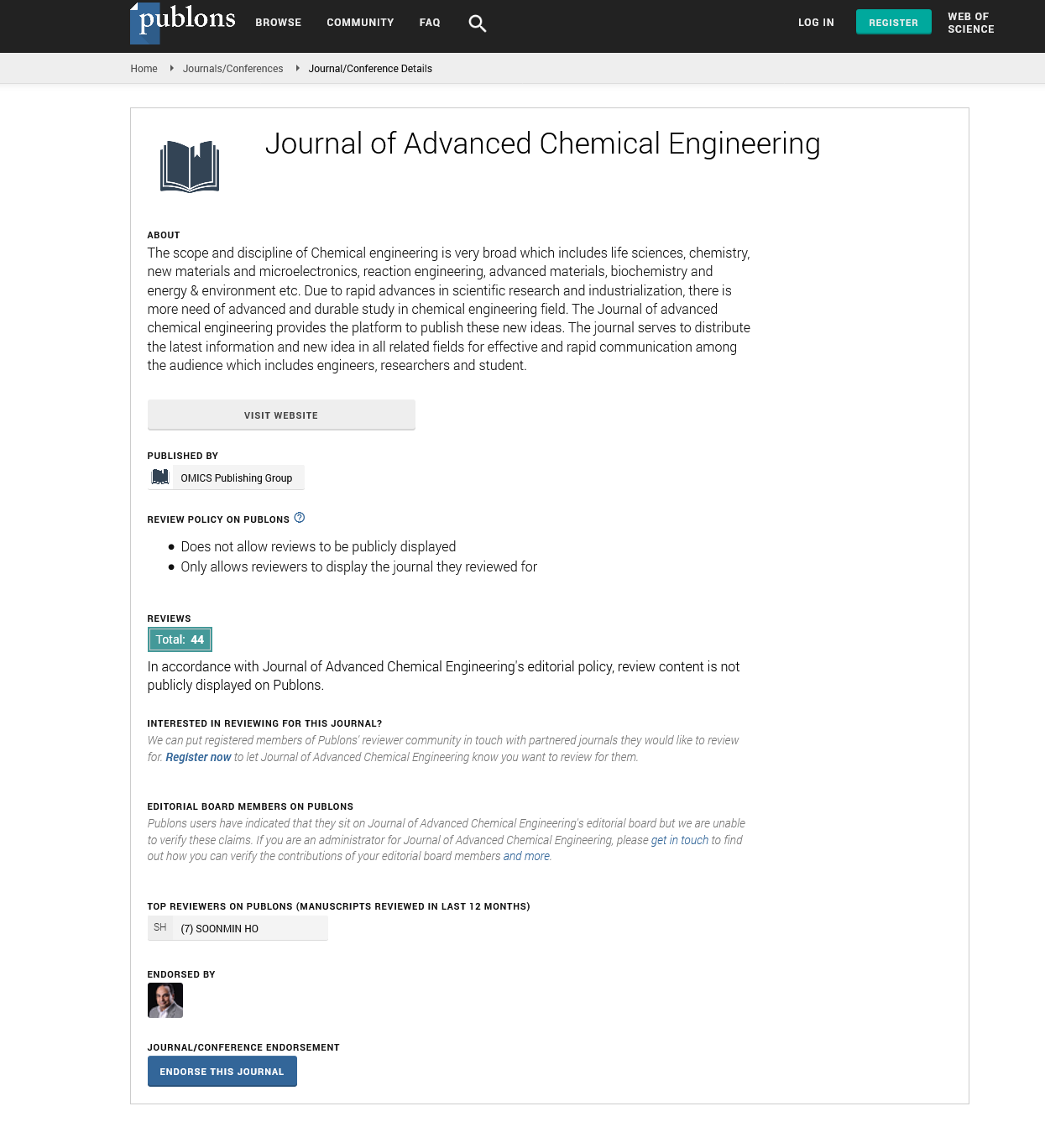Indexed In
- Open J Gate
- Genamics JournalSeek
- Smithers Rapra
- RefSeek
- Directory of Research Journal Indexing (DRJI)
- Hamdard University
- EBSCO A-Z
- OCLC- WorldCat
- Scholarsteer
- Publons
- Geneva Foundation for Medical Education and Research
- Google Scholar
Useful Links
Share This Page
Journal Flyer

Open Access Journals
- Agri and Aquaculture
- Biochemistry
- Bioinformatics & Systems Biology
- Business & Management
- Chemistry
- Clinical Sciences
- Engineering
- Food & Nutrition
- General Science
- Genetics & Molecular Biology
- Immunology & Microbiology
- Medical Sciences
- Neuroscience & Psychology
- Nursing & Health Care
- Pharmaceutical Sciences
Commentary - (2023) Volume 13, Issue 1
Ion Exchangers: It's Types and Applications
Wu Yan*Received: 03-Feb-2023, Manuscript No. ACE-22-19695; Editor assigned: 06-Feb-2023, Pre QC No. ACE-22-19695 (PQ); Reviewed: 21-Feb-2023, QC No. ACE-22-19695 ; Revised: 28-Feb-2023, Manuscript No. ACE-22-19695 (R); Published: 07-Mar-2023, DOI: 10.35248/2090-4568.23.13.266
Description
Ion exchange membranes have changed over the past 50 years from being a laboratory tool to industrial goods with substantial technological and economic significance. Ion exchange membranes are successfully used nowadays to treat industrial effluents and desalinate sea and brackish water. They are gaining a lot of attention. They are effective tools for the concentration or separation of ionic species-containing foods, pharmaceuticals, and basic chemical goods. The invention of an ion exchange membrane makes society more sustainable by recovering usable effluents that would otherwise go to waste, in addition to making the process cleaner and more energy-efficient.
The use of molten salt at temperatures below the glass annealing range, which results in a large for tiny ion exchange, as well as other physical and chemical methods of strengthening glass. It has been demonstrated that abrasion of treated glass significantly reduces the strength of commercial and experimental alkali-lime- silica glasses. Alkali-alumina-silica and alkali-zirconia-silica treated glasses are less susceptible to abrasion, nevertheless. With an increase in alumina or zirconia content, the strength after abrasion reaches 117,000 psi for cane made of a 35% alumina glass. The presence of aluminium or zirconium in the lattice may have created a unique ionic environment, which could be the source of the aluminium or zirconium effect.
Since the initial reports of the ion exchange behaviour of zirconium phosphate gels in the chemical literature, it has been more than twenty years. Since then, investigation into the nature of these and related substances has gone on without pause. The ability to manufacture zirconium and titanium phosphates in crystalline form provided some of the drive for this research. In the meanwhile, dozens of swapped forms as well as numerous additional layered group (IV) phosphates and arsenates have been crystallized and examined. Additionally, a sizable number of zirconium phosphate phases are been recognized. Additionally, zirconium bis (monohydrogen orthophosphate), the original, can be found as a gel, as a single crystal, and in all other intermediate crystallinity phases.
Ion exchange behaviour varies for each of these products depending on the crystallinity and structure. Therefore, it is incorrect to think of zirconium phosphates as a single substance. The exchanger must be accurately defined in order to understand the observed behaviour. They will make every effort to do this in order to establish a logical relationship between structure and behaviour.
Types of ion exchangers
Ion exchangers are divided into two categories based on their functionality and the support matrix's physical characteristics. According on their capacity to exchange positively or negatively charged species, cation and anion exchangers are categorized. Ionized strongly acidic and strongly basic ion exchangers are functional at almost all pH levels (pH 0–14). In the pH range of 5 to 14, weakly acidic exchangers are often successful. Resins that are weakly basic work well in the pH range of 0 to 9. Although weakly basic and acidic exchangers are frequently simpler to renew, leakage from incomplete exchange may happen. Iminodiacetic acid-based chelating resins create certain metal complexes with metal ions that have complex stability constants that follow the same progression as those for EDTA. However, they can also act as weak cation exchangers depending on the pH.
The concentration of ionogenic groups and their accessibility as an exchange site determine the possible ion-exchange capacity. The support matrix is a function of the latter.
Resins are synthetic ion-exchangers made of polymers that are commercially available in gel-like or genuinely porous forms. Since their structure depends on swelling in the solvent they are submerged in, gel-type resins are not porous in the traditional sense.
The three-dimensional structure typically collapses when the solvent is removed, and no appreciable surface area or pore diameter can be determined using the standard methods available for really porous materials. Gel-type resins resemble a real molecular-scale solution when they are swelled.
Citation: Yan W (2023) Ion Exchangers: It’s Types and Applications. Adv Chem Eng. 13:266.
Copyright: © 2023 Yan W. This is an open-access article distributed under the terms of the Creative Commons Attribution License, which permits unrestricted use, distribution, and reproduction in any medium, provided the original author and source are credited.

